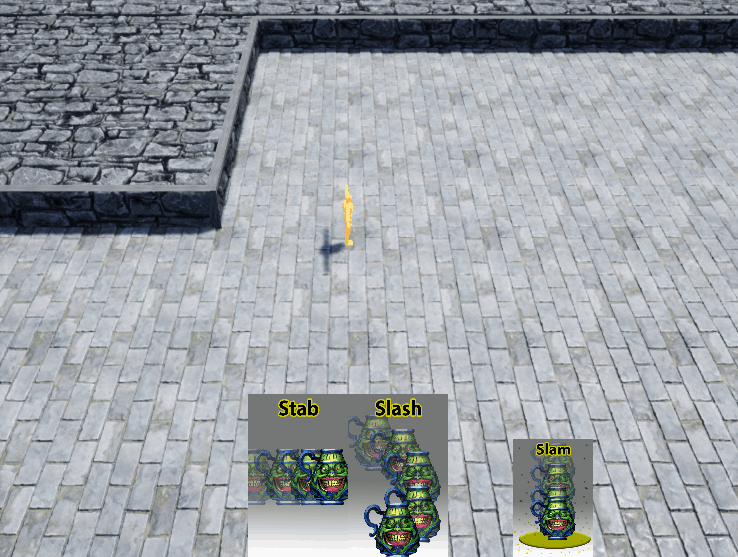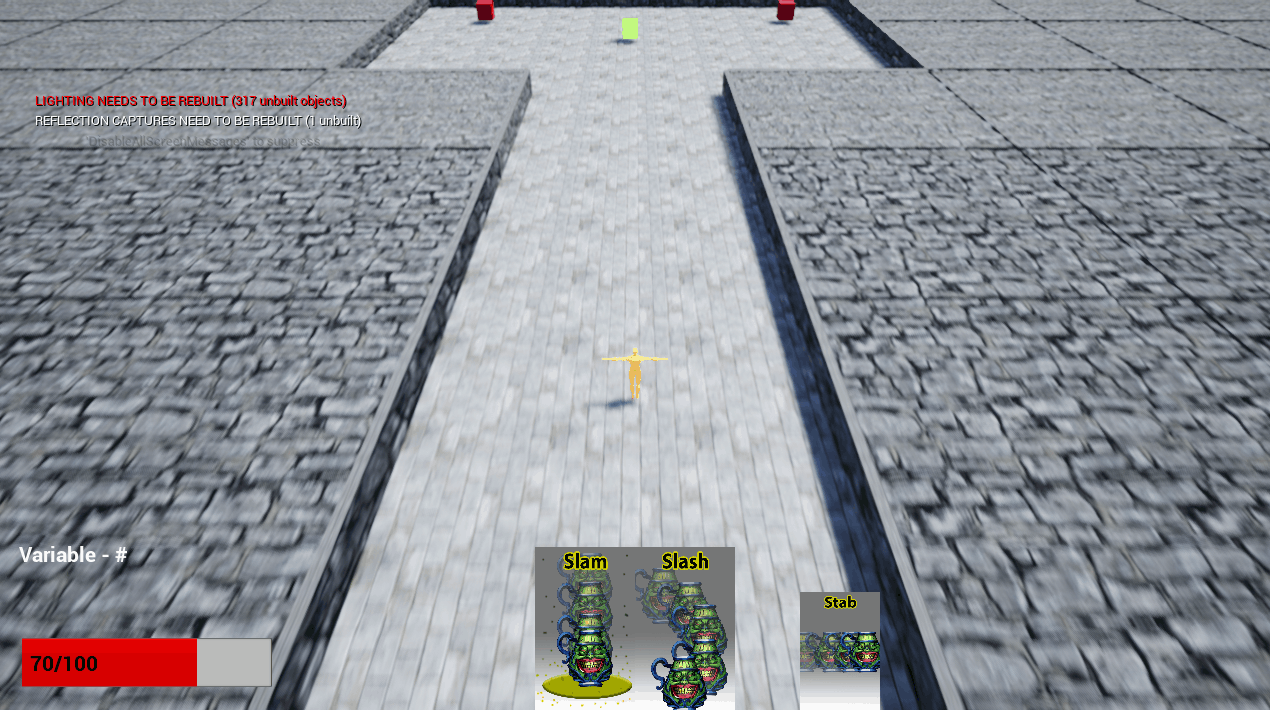Recap and Review
There has been A LOT of reworks and replanning and redoing going on with the project. There’s been so much that we haven’t been keeping you all informed on here. But that’s going to change right now! I will be going over our entire project’s plan to date and review our process in developing our game: X-iled.

A Curse in the Dungeon
Remember when we wanted to create a RPG-style game with a unique battle mechanic? I hardly do. We’ve had this idea changed for a few months now, but our previous posts may not have covered it that well. So let me introduce you to our new game, which is a 2.5D Action Rogue-lite Deckbuilder! You play as a monster that will fight against other monsters in order to escape this massive underground dungeon. Lost? Here, follow me into the pit.
The dungeon keeps the corpses of the dead monsters in this pit at the bottom of the dungeon. But you, however, are a curse that is able to possess the bodies of the dead and use their abilities against the other monsters. You’ve been trapped down in this pit for who knows how long, and your only instinct is to escape. The monsters of this dungeon all harness their abilities into cards, which conveniently can be taken from other monsters to add to your own arsenal of attacks. Defeat strong monsters, gain more powers, and fight your way to the surface. There are also guards, which are monsters with tremendous power, that will prevent your escape, but defeating them will grant you keys. Gather enough of these keys, and you’ll be able to exit the dungeon…but there may be a greater threat lurking in the shadows. In the end, it all boils down to these three concepts:
- Defeat monsters
- Obtain cards
- Escape the dungeon
Slam n Slash
As much as I could go on about the concept, I’m sure that you’d rather see what I’m talking about than read it. So here’s a short preview of our demo so far. Your hand of cards is shown at the bottom, along with a smaller card defined as the next card in your deck. Using a card will put it back into the end of your deck, and the next card will replace the slot of the card that you used. Attacks will always be cycling in and out with this system, giving constantly changing options for combat. We can’t wait to see the synergies that come out of different attacks used consecutively when we add in more.

Enemies in the demo are shown as floating cubes. The red cubes resemble normal enemies. Blue cubes resemble Brutes, which drop a card when they are defeated. Green cubes are Guards, which is the boss of the level that will drop a key when defeated. (Names are subject to change). So far, all three of these types of enemies only run and shoot at you. Perfect for combat practice! Evade attacks with the swift dash, then slash in to deal a satisfying 20 damage to those enemies. Got a bunch of enemies together? Slam down on them all, destroying the ground as well as any enemies that were unfortunately standing there.

Reiterate, Reiterate, Reiterate
Now that you’re all caught up to speed for what the game is now, perhaps you would want to know why all these changes have happened. It’s been a long journey filled with feedback, critique, and a lot of back and forth about design decisions. It has not been easy nor pleasant, but we are making every step closer to the game we want to happen. After the change to Unreal, as mentioned in one of our previous posts, we wanted our game to be a 3D rogue-lite rather than a 2.5D one. We aimed for natural procedural generation and multitudes of monster models and lots of variations to our combat system.
And then we got slapped hard with feedback of our scope. As it was very well-deserved. Our ideas were very ambitious and overbearing on all sorts of areas; art, balance, AI, everything. So what was suggested to us instead was to translate our game into 2D to make things easier. Well…we still wanted to work with 3D space, so we made a comrpomise of changing to 2.5D view. While this doesn’t alleviate any art issues, it does make other things easier such as the procedural generation and designing mechanically in 2D space rather than 3D.
We then got slapped some more afterwards, and found it best to reduce our scope further. We narrowed down the attacks and made the combat system the main focus. Instead of having a bunch of random, uncorrelated attacks, we put three attacks together that work well with each other. And we polished them! We made sure that these attacks felt great, because that’s really the important part of the game: a great combat system. So, simplifying the concept more, we put most of our work and time into the attack system, fleshed it out, made a simple level to show it off in and boom! You get what you see here now.

So that’s a brief summary of what had happened in our process the past few months. In hindsight, things I would’ve done differently was to focus on one system at a time. It’s vitally important to make sure that your base game works before you keep branching off into more and more ideas. Hopefully we won’t fall into that trap again!
Winter is Coming
And that leaves us to where we are now. We’ve got our prototype demo done. While it doesn’t have much content, we made sure it felt good to control and engage in combat. We will be continuing in this direction to ensure that our combat system will be the main engaging aspect and keep improving until we can’t improve anymore. Nate has been making great progress in the procedural generation department, as shown with his last blog post on Wave Function Collapse. Things are starting to come closer together and it’s been very exciting!
It’s been a long few months though, so it’s most likely that we may slow down over these next two months or so and give ourselves more of a break. But we won’t be stopping! Expect more updates soon, and let us know how you feel about where we’re headed.
Good luck, because you’ll need it to escape.
X-iled By: David Liu